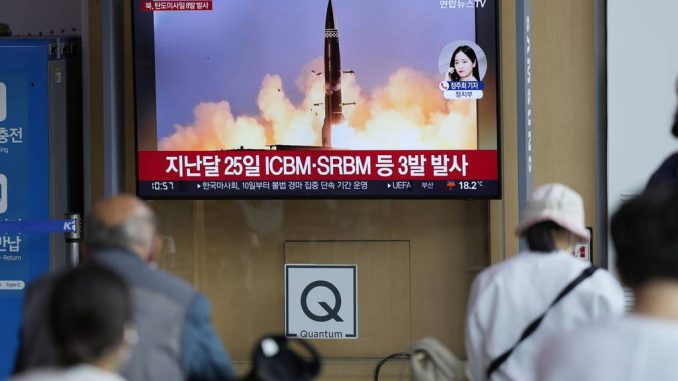
SEOUL, South Korea — North Korea test-fired a barrage of short-range ballistic missiles from multiple locations toward the sea on Sunday, South Korea’s military said, extending a provocative streak in weapons demonstrations this year that U.S. and South Korean officials say may culminate with a nuclear test explosion.
Possibly setting a single-day record for North Korean ballistic launches, eight missiles were fired in succession over 35 minutes from at least four different locations, including from western and eastern coastal areas and two inland areas north of and near the capital, Pyongyang, South Korea’s Joint Chiefs of Staff said.
It said the missiles flew 110 to 670 kilometers (68 to 416 miles) at maximum altitudes of 25 to 80 kilometers (15 to 56 miles).
Hours later, Japan and the United States conducted a joint ballistic missile exercise aimed at showing their “rapid response capability” and “strong determination” to counter threats, Japan’s Defense Ministry said in a statement.
South Korean Joint Chiefs of Staff Chairman Gen. Won In-Choul held a video conference with Gen. Paul LaCamera, an American general who heads the South Korea-U.S. combined forces command in Seoul, and they reaffirmed the allies’ joint defense posture, according to the military in Seoul.
Sung Kim, U.S. President Joe Biden’s special envoy for North Korea, also discussed the launches with South Korean officials while on a visit to Seoul. They expressed “deep regret” that North Korea was continuing weapons development despite grappling with a COVID-19 outbreak at home, Seoul’s Foreign Ministry said.
Japanese Defense Minister Nobuo Kishi said none of the missiles fell inside Japan’s exclusive economic zone.
RELATED
:quality(70)/cloudfront-us-east-1.images.arcpublishing.com/mco/M4EZ4CVMSVAS5PD6GY5PE6MPHI.jpg)
The launches came a day after the U.S. aircraft carrier Ronald Reagan concluded a three-day naval drill with South Korea in the Philippine Sea, apparently their first joint drill involving a carrier since November 2017, as the countries move to upgrade their defense exercises in the face of North Korean threats.
North Korea has long condemned the allies’ combined military exercises as invasion rehearsals and often countered with its own missile drills, including short-range launches in 2016 and 2017 that simulated nuclear attacks on South Korean ports and U.S. military facilities in Japan.
Discussing the launches with his national security officials, South Korean President Yoon Suk Yeol lamented that North Korea was firing missiles at a pace of once every nine days this year. He vowed to strengthen the country’s defense in cooperation with the United States, according to his office.
The launches marked North Korea’s 18th round of missile tests in 2022 alone — a streak that has included the country’s first demonstrations of intercontinental ballistic missiles in nearly five years.
Experts say North Korean leader Kim Jong Un wants to force the United States to accept the idea of the North as a nuclear power and negotiate economic and security concessions from a position of strength.
South Korean and U.S. officials say there are signs that North Korea is also pressing ahead with preparations at its nuclear testing ground in the northeastern town of Punggye-ri. The North’s next nuclear test would be its seventh since 2006 and the first since September 2017, when it claimed to have detonated a thermonuclear bomb to fit on its ICBMs.
On Friday, Sung Kim, the U.S. envoy, said Washington is “preparing for all contingencies” in close coordination with its Asian allies. The United States has vowed to push for additional international sanctions if North Korea conducts a new nuclear test, but the prospects for further U.N. Security Council measures appear dim.
Russia and China vetoed a U.S.-sponsored resolution that would have imposed additional sanctions on North Korea over its latest ballistic tests on May 25, which South Korea’s military said involved an ICBM on a medium-range trajectory and two short-range weapons. Those tests came as Biden wrapped up his trip to South Korea and Japan, where he reaffirmed the U.S. commitment to defend both allies.
North Korea in March launched an ICBM almost straight up at a full-range and saw it fly higher and longer than any weapon it had ever tested, demonstrating the potential to reach the entirety of the U.S. mainland.
While Kim’s ICBMs have garnered much international attention, he has also spent the past three years expanding his arsenal of shorter range solid-fuel missiles threatening South Korea and Japan. He has punctuated his tests with repeated comments that the North would use its nuclear weapons proactively when threatened or provoked, which experts say portend an escalatory nuclear doctrine that may create greater concerns for neighbors.
Nuclear negotiations between Washington and Pyongyang have stalled since 2019 over disagreements in exchanging the release of crippling U.S.-led sanctions for the North’s disarmament steps.
Despite deepening economic woes, Kim has shown no willingness to fully surrender an arsenal he sees as his strongest guarantee of survival and is clearly trying to convert the dormant denuclearization talks into a mutual arms reduction negotiation with the United States, experts say.
Kim’s pressure campaign comes as the country deals with a deadly COVID-19 outbreak across his largely unvaccinated autocracy that lacks public health tools.
GAVI, the nonprofit that runs the U.N.-backed COVAX distribution program, said Friday it understands that North Korea has accepted an offer of vaccines from ally China and has started to administer doses. It isn’t immediately clear how many doses of which vaccines the North received or how the country was rolling them out.
Asssociated Press writer Mari Yamaguchi in Tokyo contributed to the report.



:quality(70)/cloudfront-us-east-1.images.arcpublishing.com/mco/BANK3JKEZZBIRGRK5JZQ3CETTY.jpg)
:quality(70)/cloudfront-us-east-1.images.arcpublishing.com/mco/ZRNDJEJ4KJF53CPSH6DVTHHSCY.jpg)
:quality(70)/cloudfront-us-east-1.images.arcpublishing.com/mco/YPDKDBNZ2FDBVOK2BEGQULLFH4.jpg)
:quality(70)/cloudfront-us-east-1.images.arcpublishing.com/mco/QCIBTXD2CBB5BE3VMBNA6YUJGE.jpg)
Be the first to comment